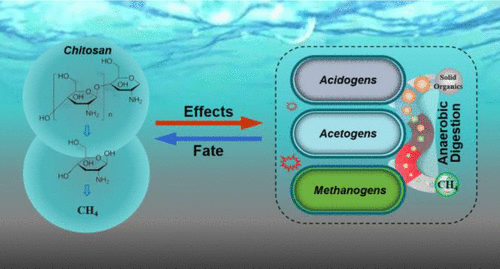当前位置:
X-MOL 学术
›
Environ. Sci. Technol.
›
论文详情
Our official English website, www.x-mol.net, welcomes your
feedback! (Note: you will need to create a separate account there.)
How Does Chitosan Affect Methane Production in Anaerobic Digestion?
Environmental Science & Technology ( IF 10.8 ) Pub Date : 2021-11-17 , DOI: 10.1021/acs.est.1c04693 Xuran Liu 1, 2 , Mingting Du 1, 2 , Qi Lu 1, 2 , Dandan He 1, 2 , Kang Song 3 , Qi Yang 1, 2 , Abing Duan 1, 2 , Dongbo Wang 1, 2
Environmental Science & Technology ( IF 10.8 ) Pub Date : 2021-11-17 , DOI: 10.1021/acs.est.1c04693 Xuran Liu 1, 2 , Mingting Du 1, 2 , Qi Lu 1, 2 , Dandan He 1, 2 , Kang Song 3 , Qi Yang 1, 2 , Abing Duan 1, 2 , Dongbo Wang 1, 2
Affiliation

|
The expanding use of chitosan in sewage and sludge treatment processes raises concerns about its potential environmental impacts. However, investigations of the impacts of chitosan on sewage sludge anaerobic digestion where chitosan is present at substantial levels are sparse. This study therefore aims to fill this knowledge gap through both long-term and batch tests. The results showed that 4 g/kg total suspended solid (TSS) chitosan had no acute effects on methane production, but chitosan at 8–32 g/kg TSS inhibited methane production by 7.2–30.3%. Mass balance and metabolism of organic analyses indicated that chitosan restrained the transfer of organic substrates from solid phase to liquid phase, macromolecules to micromolecules, and finally to methane. Further exploration revealed that chitosan suppressed the secretion of extracellular polymeric substances of anaerobes by occupying the connection sites of indigenous carbohydrates and increased the mass transfer resistance between anaerobes and substrates, which thereby lowered the metabolic activities of anaerobes. Although chitosan could be partly degraded by anaerobes, it is much more persistent to be degraded compared with indigenous organics in sludge. Microbial community and key enzyme encoding gene analyses further revealed that the inhibition of chitosan to CO2-dependent methanogenesis was much severer than that to acetate-dependent methanogenesis.
中文翻译:

壳聚糖如何影响厌氧消化中的甲烷生成?
壳聚糖在污水和污泥处理过程中的广泛使用引发了对其潜在环境影响的担忧。然而,关于壳聚糖对含有大量壳聚糖的污水污泥厌氧消化影响的研究很少。因此,本研究旨在通过长期和批量测试来填补这一知识空白。结果表明,4 g/kg 总悬浮固体 (TSS) 壳聚糖对甲烷的产生没有急性影响,但 8-32 g/kg TSS 的壳聚糖抑制了 7.2-30.3% 的甲烷产生。有机分析的质量平衡和代谢表明壳聚糖抑制了有机底物从固相转移到液相、大分子转移到小分子,最后转移到甲烷。进一步的探索发现,壳聚糖通过占据固有碳水化合物的连接位点来抑制厌氧菌胞外聚合物的分泌,增加厌氧菌与底物之间的传质阻力,从而降低厌氧菌的代谢活动。虽然壳聚糖可以被厌氧菌部分降解,但与污泥中的原生有机物相比,其降解的持久性要强得多。微生物群落和关键酶编码基因分析进一步揭示壳聚糖对CO的抑制作用 与污泥中的本地有机物相比,它更容易降解。微生物群落和关键酶编码基因分析进一步揭示壳聚糖对CO的抑制作用 与污泥中的本地有机物相比,它更容易降解。微生物群落和关键酶编码基因分析进一步揭示壳聚糖对CO的抑制作用2依赖的产甲烷作用比乙酸依赖的产甲烷作用严重得多。
更新日期:2021-12-07
中文翻译:

壳聚糖如何影响厌氧消化中的甲烷生成?
壳聚糖在污水和污泥处理过程中的广泛使用引发了对其潜在环境影响的担忧。然而,关于壳聚糖对含有大量壳聚糖的污水污泥厌氧消化影响的研究很少。因此,本研究旨在通过长期和批量测试来填补这一知识空白。结果表明,4 g/kg 总悬浮固体 (TSS) 壳聚糖对甲烷的产生没有急性影响,但 8-32 g/kg TSS 的壳聚糖抑制了 7.2-30.3% 的甲烷产生。有机分析的质量平衡和代谢表明壳聚糖抑制了有机底物从固相转移到液相、大分子转移到小分子,最后转移到甲烷。进一步的探索发现,壳聚糖通过占据固有碳水化合物的连接位点来抑制厌氧菌胞外聚合物的分泌,增加厌氧菌与底物之间的传质阻力,从而降低厌氧菌的代谢活动。虽然壳聚糖可以被厌氧菌部分降解,但与污泥中的原生有机物相比,其降解的持久性要强得多。微生物群落和关键酶编码基因分析进一步揭示壳聚糖对CO的抑制作用 与污泥中的本地有机物相比,它更容易降解。微生物群落和关键酶编码基因分析进一步揭示壳聚糖对CO的抑制作用 与污泥中的本地有机物相比,它更容易降解。微生物群落和关键酶编码基因分析进一步揭示壳聚糖对CO的抑制作用2依赖的产甲烷作用比乙酸依赖的产甲烷作用严重得多。











































 京公网安备 11010802027423号
京公网安备 11010802027423号